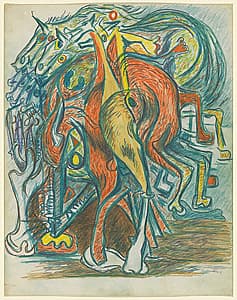

Jackson Pollock
Learn moreUntitled c.1939-42
© Pollock-Krasner Foundation. ARS/Copyright Agency Purchased 1986
More detail | PermalinkJackson Pollock was a patient of the Jungian psychologist Joseph Henderson: a treatment that coincided with the artist’s growing interest in Surrealism, and a concurrence of events that resulted in a creative outpouring. Between 1938 and 1943, Pollock produced numerous pictographic drawings based on striking symbolic motifs, including a cache of 83 drawings provided to Henderson as material for analytical aids.
Works in the collection show a close association with such ‘psychoanalytic drawings’, both in style and subject matter. In Untitled c#1939–42 the viewer is presented with the rump of a horse, shown in multiple views over several moments in time. The face of a bull appears at the lower left, looking directly at the viewer with a single yellow eye. Its enormous mass appears conjoined with the horse into a condensed, almost vortex-like accumulation of small, short pencil strokes. In the lower left corner, the horse figure dissipates into an array of empty eye sockets and skulls, finally coming to rest on the ground as a single white bone. This drawing, in particular, seems to evoke a life-and-death cycle, something that Pollock often symbolically explored in both his paintings and his drawings.
Jaklyn Babington

